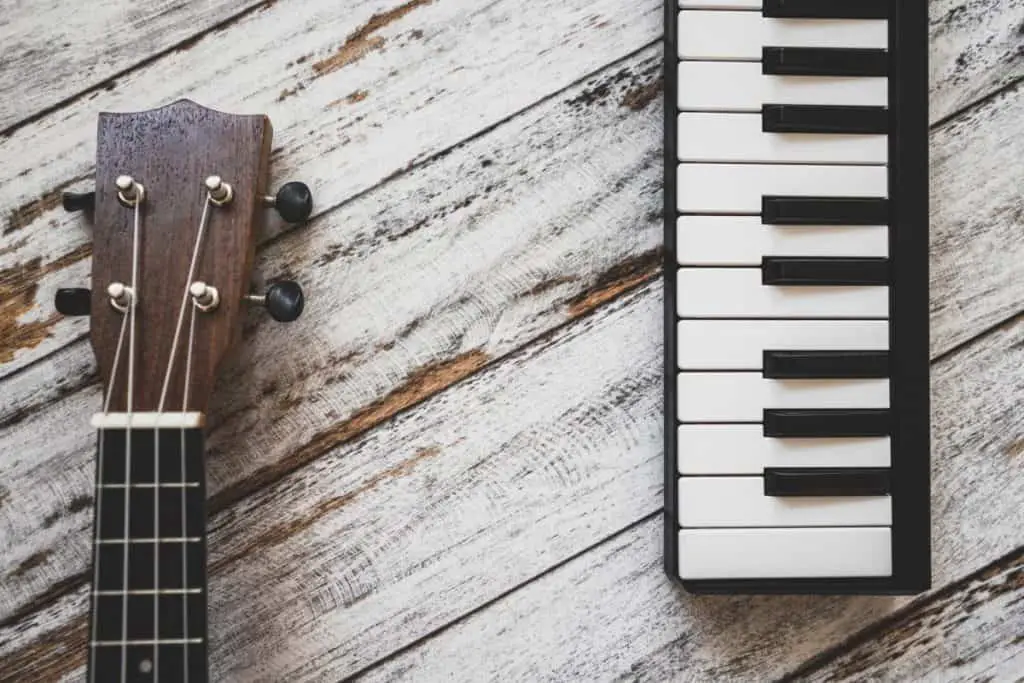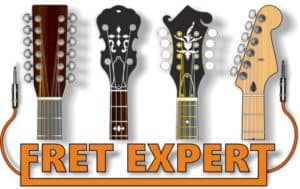Got a piece of music that you’d like to play as a ukulele and piano duet? Or just want to know which songs are good for ukulele and piano duets?
We duet a lot in our house, so I’ve put together everything you need to know about converting piano to ukulele chords and vice versa, along with some great song suggestions that should work well, too.
Covered in this Article:
Are Ukulele and Piano Chords the Same?
This is a subject that non-musicians don’t really grasp at first. Ukulele and piano chords are indeed the same.
To put it simply, it doesn’t matter if you’re playing a C major chord on a piano, ukulele, harp or hammered dulcimer, it’s still a C major chord!
If all four instruments were playing in unison, the resulting sound would be identical, other than the differences of timbre and the inherent sound variation associated with that particular instrument.
It is true that the piano is capable of producing ‘true’ complicated eleventh and thirteenth chords containing as many as five or six different notes.
However, the ukulele can also enter this harmonic realm by deconstructing those chords and only retaining the parts of that chord which give it that particular quality.
A suitable simile would be to describe the parts of elephant; you only really need the trunk and ears to instantly recognize that you’re looking at an elephant – the same is true of the harmonic qualities of many chords.

A bi-product of learning chords on a piano, ukulele or any other chordophone for that matter is the ability to start recognising which chord is likely to come next in a musical progression.
You’ll start to spot where a major chord morphs into a minor, diminished, ninth and so forth.
Music is a bit like language in that it is generally logical once you get to understand the written and sometimes unwritten harmonic rules.
That is not to say that the unexpected harmonic shift or two doesn’t produce wonderful and aurally pleasing results, but speaking generally, with a standard three-chord song, the next chord in the progression can be anticipated without having great knowledge of the subject.
After all, most rock & roll is based upon three simple chord intervals, whether it’s E, A and B or C, F & G.
How do I convert Ukulele Chords to Piano, and Vice Versa?
The easy answer is to get a chord dictionary (there are plenty of them for sale) and just look them up.
If on the other hand, you’re feeling a bit more adventurous and want to explore the fascinating world of harmonic intervals, here’s how you do it:
Sit down at your piano or virtual piano if you only have an app, with your ukulele in hand.
Start by playing a single note from one of your favorite chords. For the sake of this discussion, let’s presume you’ve already mastered the ‘C’ chord on the uke, which involves fretting the first string (the one furthest from your chin) of the uke at the third fret, using your ring finger.
This features the root note of your chord, the note of ‘C’.
The root note is the first note in the harmonic sequence of any chord. So the root note of a C major or C minor ninth, will always be ‘C’. Ditto, if the chord was an Abm7, the root note would always be ‘Ab’.

Now after you’ve plucked the ‘C’ note on your uke, hunt around for a note on the piano that sounds the same.
Obviously, if you have some experience of a piano keyboard, you’ll likely know where it is, but I’m presuming a beginner’s level of knowledge at this juncture. Most people’s ears understand the differences in pitch and you should find the identical note on your keyboard.
Using this method to hunt around the keyboard, you’ll find each of the notes in your chord, albeit in a different octave in some cases.
To understand the term octave, you only need to know that there are twelve notes in total that make up all of westernized music. This is reflected in your piano keyboard, which is split up into seven different octaves.
Technically, an octave consists of eight notes (in the key of ‘C’, that would be C, D. E, F, G, A, B and C again). But in the context of a piano or any instrument for that matter, an octave encompasses the whole chromatic scale of twelve notes – that’s seven white notes and five black notes in total.
Starting at the ‘C’ not on the piano, the first grouping consists of three white and two black notes. In the next slightly larger grouping, there are four whites and three blacks.
Put these two groupings together and you have an octave, using the full chromatic scale. It’s important to understand that it doesn’t matter which octave your string/note is in, it’s still the same note whether high or low in tone.

To form a playable chord on your piano keyboard, you need to group the separate notes in the ukulele chord together, within the confines of about one octave.
This makes playing them a lot easier. Obviously for more advanced players, they often like to mix up notes from several octaves using both hands, but for the sake of a beginner, it’s best to keep the intervals (the gaps between each note) as closely together as you can, so your fingers will fall more easily into the correct positions.
So to return to your ‘C’ chord, your second string features the note of ‘E’ which is referred to as a third or major third, followed by your 3rd string which is another ‘C’ or root note, albeit an octave lower.
Finally, we have the 4th string, which features the note ‘G’, described in musical parlance as a perfect fifth.
The twelve intervals in the chromatic scale are listed below for your reference.
In the example I’m giving, I’m featuring the key of ‘C’. The entries in bold are the notes mentioned above to create your ‘C’ chord.
Root or 1st note: C
Minor 2nd: Db
Major 2nd: D
Minor 3rd: Eb
Major 3rd: E
Perfect 4th: F
Augmented 4thor Diminished 5th: F# or Gb
Perfect 5th: G
Minor 6th: Ab
Major 6th: A
Minor 7th: Bb
Major 7th: B
Music theory or more specifically in this case, harmonic theory is another blog in itself, but hopefully this has given you a taster of what’s ahead to whet your appetite!
Which songs make good Ukulele Piano Duets?
If one or both of you is new to music and want to keep it simple, then start with something that is playable by both parties.
There are thousands of three-note chords in existence, but here are a few suggestions using just the chords of C, F and G (some won’t be in the original key):
All the following songs make great ukulele/piano duets:
- Already Gone (The Eagles)
- Amazing Grace (Traditional)
- Bad Moon Rising (Creedence Clearwater Revival)
- Barbara Ann (The Beach Boys)
- Be-Bop-A-Lula (Gene Vincent)
- Blowin’ in the Wind (Bob Dylan)
- Brown Sugar (Rolling Stones)
- Cecelia (Simon & Garfunkel)
- Down on the Corner (Creedence Clearwater Revival)
- Fifty Ninth Bridge Street Song (Feelin’ Groovy) (Simon & Garfunkel)
- Folsom Prison Blues (Johnny Cash)
- Hang on Sloopy (The McCoys)
- Heartbreak Hotel (Elvis Presley)
- Hound Dog (Elvis Presley)
- I Love Rock and Roll (Joan Jett)
- Kum Ba Yah (traditional)
- La Bamba (Richie Valens)
- Love Me Do (The Beatles)
- The Mighty Quinn (Bob Dylan / Manfred Mann)
- Mull of Kintyre (Paul McCartney & Wings)
- Not Fade Away (Buddy Holly / Rolling Stones)
- Ring of Fire (Johnny Cash)
- Roll Over Beethoven (Chuck Berry / ELO)
- Route 66 (Bobby Troup)
- Silent Night (Traditional)
- Sloop John B (The Beach Boys)
- Spirit in the Sky (Norman Greenbaum)
- Stuck in the Middle with You (Steeler’s Wheel)
- Sweet Home Alabama (Lynyrd Skynrd)
- Wild Thing (The Troggs)
- Will the Circle be Unbroken (Traditional)
The above list only includes songs using the C, F and G chord combination, but will work equally well using the same chord progression sequence in another key, including D, G and A or the more difficult E, A, and B.
Guitarists and baritone ukeists will find E, A and B, relatively easy, because the fingering is fairly straightforward.
Learning to play in different keys is very useful to provide variation and find a key more suitable for your voice.
Have fun!
